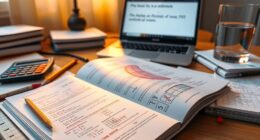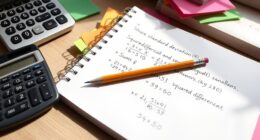To write effective hypothesis statements, focus on grounding your ideas in existing research and clearly defining your variables. Make your hypothesis specific, measurable, and focused on the relationships you want to test. Avoid vague or broad statements, and verify it’s testable. Highlight the population, intervention, and expected outcomes. If you follow these guidelines, you’ll craft a solid hypothesis that guides your research efficiently—learn more to refine your approach further.
Key Takeaways
- Ensure your hypothesis is specific, measurable, and grounded in existing research.
- Clearly define variables, population, and timeframe to enhance clarity.
- Base your hypothesis on prior evidence, avoiding assumptions or vagueness.
- Make hypotheses testable by specifying expected relationships or outcomes.
- Use detailed descriptions to guide experimental design and facilitate analysis.

Have you ever struggled to clearly define what you expect to find in your research? If so, you’re not alone. Crafting a solid hypothesis statement can be challenging, especially if you’re unsure how to approach it or where to start. One of the most effective ways to guarantee your hypothesis is well-formed is to develop solid research strategies. These strategies help you narrow down your focus, identify relevant variables, and formulate a clear, testable statement. A good research strategy begins with a thorough review of existing literature to see what has already been explored and where gaps might exist. This groundwork informs your hypothesis, making sure it’s grounded in prior knowledge and relevant to your field. When you take the time to plan your research strategies carefully, you reduce the risk of falling into common pitfalls that can weaken your hypothesis or make your research less effective. One common pitfall is creating a hypothesis that’s too broad or vague, which makes it difficult to test or interpret results. For example, stating “Exercise improves health” is too general; instead, specify what kind of exercise, what health outcomes, or the population you’re studying. Another mistake is formulating a hypothesis based on assumptions rather than evidence. Jumping to conclusions without sufficient background can lead you astray and undermine the credibility of your research. To avoid these pitfalls, make certain your hypothesis is specific, measurable, and grounded in existing evidence. It should also be testable—meaning you can design experiments or observations that will confirm or refute it. Furthermore, your research strategies should include identifying variables clearly. Knowing which factors you’re examining helps you craft a hypothesis that’s both precise and actionable. For example, instead of hypothesizing “Diet affects weight,” specify “A high-protein diet reduces weight in overweight adults over 12 weeks.” This clarity guides your experimental design and data collection. Additionally, understanding how contrast ratio influences image quality in projectors can inspire more precise hypotheses about visual perception or display technology. Remember, a well-constructed hypothesis acts as a roadmap for your entire research process. It provides direction, helps focus your efforts, and makes it easier to analyze your findings. By paying close attention to research strategies and avoiding common pitfalls, you’ll develop hypotheses that are meaningful, testable, and valuable for advancing knowledge. Taking the time upfront to craft a strong hypothesis statement ultimately makes your research more organized, credible, and impactful.
Frequently Asked Questions
How Do I Choose Variables for My Hypothesis?
For your hypothesis design, you should choose variables that are relevant and measurable to your research question. Focus on variables that can show a clear relationship or effect, like independent and dependent variables. Consider variables that are controllable and easy to manipulate or observe. Good variable selection makes your hypothesis more precise and testable, helping you gather meaningful data and draw valid conclusions.
What Are Common Mistakes in Hypothesis Writing?
Don’t let research errors trip you up—common pitfalls in hypothesis writing include vague or overly broad statements, which can derail your project. You might also fall into the trap of making assumptions without evidence or framing your hypothesis as a question rather than a clear prediction. Avoid these mistakes by being specific, testable, and focused, ensuring your hypothesis guides your research effectively and keeps errors at bay.
How Specific Should My Hypothesis Be?
Your hypothesis should be specific enough to guide your research clearly, following clarity guidelines that prevent ambiguity. Aim for research specificity by clearly defining variables and expected relationships, so your hypothesis is testable and focused. Avoid vague language; instead, use precise terms that reflect your study’s scope. This approach helps you stay on track and makes your findings meaningful, ensuring your hypothesis effectively directs your investigation.
Can a Hypothesis Be Revised After Initial Formulation?
Did you know that 70% of researchers revise their hypotheses during experiments? Yes, your hypothesis can definitely be revised after initial formulation. The revision process is common and essential for accurate research. You should adjust your hypothesis as you gather data, improving clarity and focus. This flexibility helps guarantee your study remains relevant and meaningful, ultimately strengthening your findings and contributing to scientific progress.
How Do I Test the Validity of My Hypothesis?
You test the validity of your hypothesis by designing experiments or studies that follow research ethics, ensuring participants’ rights are protected. Collect data using appropriate data analysis techniques like statistical tests or qualitative methods. Then, compare your results to your hypothesis. If the data supports it, your hypothesis gains validity; if not, consider revising or refining it. Always adhere to ethical standards during your testing process.
Conclusion
Now that you know how to craft clear hypothesis statements, you’re ready to make your research focused and effective. For example, if you’re studying how exercise impacts mood, your hypothesis might be, “Regular aerobic exercise improves students’ overall mood.” By following these guidelines, you’ll set a strong foundation for your study. Remember, a good hypothesis guides your research and keeps you on track to find meaningful results.










